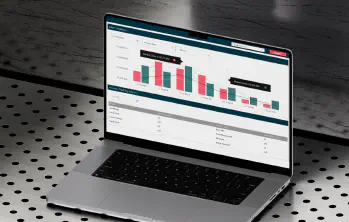Market Volatility and Trade Surveillance: A Modern Appoach
Trade Surveillance and Market Abuse During Times of Volatility
In the past several months, the widespread impact of rising interest rates, global supply chain issues and record levels of inflation has been felt across markets globally. In the US markets, the value of publicly traded US stocks is down $9 trillion since the start of 2022; the value of cryptocurrencies is currently well below their peak, leading to lower user adoption rates; and a recent profit warning from Credit Suisse led to losses across Europe.
While this volatility has caused major uncertainty for investors, regulators still expect firms to fulfil their usual regulatory obligations. However, during periods of high market volatility such as this, meeting these obligations becomes increasingly difficult.
One area of regulatory compliance which is impacted particularly heavily by this phenomenon is trade surveillance. Monitoring trades for market abuse and insider trading using a simple, rule-based surveillance system during extended periods of market volatility creates obvious difficulties when setting tolerances and testing parameters. This, in turn, can lead to a vast increase in false positives, or worse: manipulative trading slipping through the net.
The root cause of this issue is an overly static approach to trade surveillance. For example, a simple, static insider-trading test might trigger an alert when it is found that a trader took a position in a security prior to a price movement or an item of news which might cause a subsequent price movement. In times of relative market tranquillity, this may not cause an issue. However, during periods of market volatility, violent and rapid swings in instrument price are not uncommon, meaning that the static approach would lead to huge quantities of false positive alerts. This in turn would cause compliance teams to waste time clearing irrelevant alerts,increasing the likelihood of actually manipulative trading not being captured in a timely fashion.
The Solution - Conditional Parameters
The solution to this problem is to implement a surveillance system which is able to account for market volatility. By utilising machine learning based trade surveillance systems such as TZ to provide users with the ability to set conditional parameters which can recognise market volatility and filter our false positives without any manual intervention from the user.
Conditional parameters allow users to set different tolerances for various forms of market abuse which will then be implemented when particular market conditions are met. TZ can recognise abnormally large price movements in particular instruments, then analyse this movement to determine whether or not trading which takes place around this event should be regarded as suspicious.
This is an opinion shared by the FCA. The UK regulator recently advocated for the use of conditional parameters when monitoring for market abuse in the latest edition of their Market Watch newsletter.
The utility of conditional parameters extends beyond widespread market volatility as well. Even during periods of relatively low volatility, conditional parameters provide compliance teams with the ability to implement flexible tolerances which can account for a variety of criteria such as instrument liquidity, trade volume, execution methods, price, and any other parameterised setting within TZ.
Conditional parameters - also sometimes referred to as ‘dynamic parameters’ - allow users to categorise records in accordance with various metrics and apply different testing parameters conditionally/dynamically depending on the exact nature of the record being tested. An example could be a client applying a subset of parameters based on a particular instrument or client/entity, strategy or execution method (DMA) etc.
With no end in sight to this market volatility, compliance teams will be stretched more thinly than ever. As such, an automated and sophisticated trade surveillance solution is a must-have. By reducing the compliance workload, this approach not only reduces false positives, but frees up time to ensure real market abuse is monitored and dealt with.



